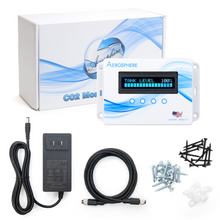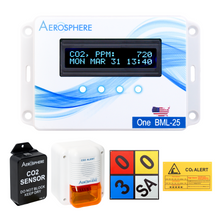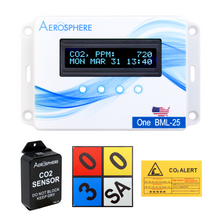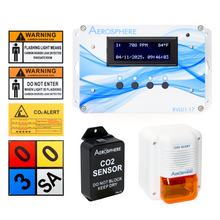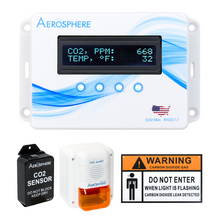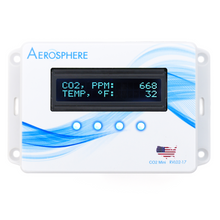Why You Wake Up Groggy: CO2 Levels in Bedrooms and Sleep Quality
Air quality and high CO2 levels can disrupt the sleep cycle, leading to grogginess, headaches, and poor concentration.

Everyone has gone through a situation where they had a problem staying or falling sleep. However, it's not always a busy mind to be blamed. There could be issues such as poor sleeping habits, stress, or even an uncomfortable mattress, but one factor people sometimes overlook is the air quality in a bedroom.
According to this study by the National Library of Medicine (NIH), people tend to spend a greater percentage of their time in bed asleep when they sleep in a comfortable temperature and good air quality, as indicated by lower CO2 levels. Having high levels of carbon dioxide can have a huge impact on one's sleep. When CO2 builds up in the air from poor air ventilation, the air can turn stale and turn stuffy, which can interfere with the body's natural sleep cycle, leading to disruptions in deep and REM sleep.
This article will examine how CO2 levels affect sleep, how to identify high CO2 levels and the steps on how to improve one's air quality for more restful nights.

How Carbon Dioxide Affects Sleep
In a bedroom, CO2 is mainly generated by the people sleeping in it. As humans breathe, they exhale CO2, which accumulates in the air, especially if the room is poorly ventilated. When windows are closed and airflow is limited, the CO2 concentration can rise greatly throughout the night.
Understanding the Sleep Cycle
According to the NIH, a normal sleep cycle goes through two phases of sleep: rapid eye movement (REM) and non-REM sleep. Non-REM sleep goes through three phases:
- Stage 1: The transition between wakefulness and sleep
- Stage 2: At this stage, you are asleep
- Stage 3: This is what's often called deep sleep or slow-wave sleep.
REM sleep involves rapid eye movement and active brain activity, which is similar to how a normal brain functions when the body is awake. Your blood pressure, heart rate, brain activity, and breathing increases.
Unfortunately, CO2 buildup can interfere with these stages, particularly deep sleep and REM sleep, leading to grogginess. This disruption leads to fragmented sleep, preventing the body to fully recover and cause the body to shift out of the deeper sleep cycle. And as CO2 levels rise, oxygen levels can decrease. Oxygen is crucial for the body and brain to fully function properly during sleep, supporting processes like memory consolidation, muscle repair, and immune function. Inadequate oxygen during sleep can lead to shallow, poor-quality sleep, leaving the body and mind feeling unrefreshed the next morning.
Identifying and Addressing High CO2 Levels
High CO2 levels in a bedroom can significantly impact how well someone sleeps and how they feel upon waking. Common signs that CO2 levels are elevated include:
- Grogginess: One of the most noticeable effects of poor air quality is feeling unusually tired or sluggish upon waking, even after a full night’s sleep. This grogginess is often a result of disrupted deep and REM sleep caused by low oxygen levels.
- Headaches: High CO2 concentrations can cause headaches, as the body’s attempt to compensate for the lack of oxygen leads to tension and discomfort, particularly around the temples and forehead.
- Poor Concentration: Elevated CO2 levels can affect cognitive function, making it harder to concentrate or think clearly in the morning. This is because the brain hasn’t received the adequate oxygen it needs for proper cognitive performance during sleep.
In addition to the physical symptoms, a room with high levels of CO2 would have the following symptoms:
- Stale Air: If the room feels stuffy or the air smells musty, this could be a sign that CO2 levels are rising. Stale air often accompanies poor ventilation and a buildup of CO2.
- Difficulty Breathing: In extreme cases, individuals may notice that it feels harder to breathe or that they wake up feeling short of breath.

Improving Sleep Environment and Hygiene
Other factors, such as cleanliness, sleeping habits, and noise levels also affect sleep quality. A well-ventilated room is only one part of creating an ideal sleeping environment. It's important to take account of any small particles that permeate the space. Dust, pollutants, and allergens can make the air quality stuffy and stale.
Investing in an air quality monitor, such as the Aerosphere® CO2 Indoor Air Quality Monitor, can significantly enhance your sleep environment by providing real-time insights into CO2 concentrations, helping you identify areas with poor ventilation. Maintaining CO2 levels between 700-1000 ppm is ideal for optimal air quality and better sleep.
Here are some other improvements you can do with your space:
- Open Windows: Allowing fresh air to circulate by opening a window can help lower CO2 levels. If outdoor air quality is a concern, using an air purifier with a HEPA filter can help remove pollutants while maintaining airflow.
- Use Air Purifiers and Fans: Air purifiers can help improve air quality by filtering out allergens and pollutants, while fans can keep air moving and prevent CO2 from accumulating in stagnant areas.
- Upgrade HVAC Systems: Ensuring that heating, ventilation, and air conditioning (HVAC) systems are well-maintained and equipped with fresh air intake options can help regulate indoor air quality effectively.
-
Indoor Plants: Adding plants to a space can not only spruce the place up, but also purify the air. Learn more about what type of plants benefit each living space here.
- Sleep hygiene: It's important to practice proper sleep hygiene to enhance overall sleep quality, such sleeping for a full eight hours and placing any electronic devices away to prevent oneself from staying up.
Conclusion
Maintaining good air quality in the bedroom is essential for achieving deep, restful sleep. High CO2 levels can disrupt the sleep cycle, leading to grogginess, headaches, and poor concentration. And by recognizing the signs of elevated CO2 levels and taking proactive steps, such as improving ventilation, using air purifiers, and monitoring CO2 levels, individuals can create a healthier sleep environment. Investing in better air quality leads to more restorative sleep, helping people wake up feeling refreshed and ready to take on the day.

